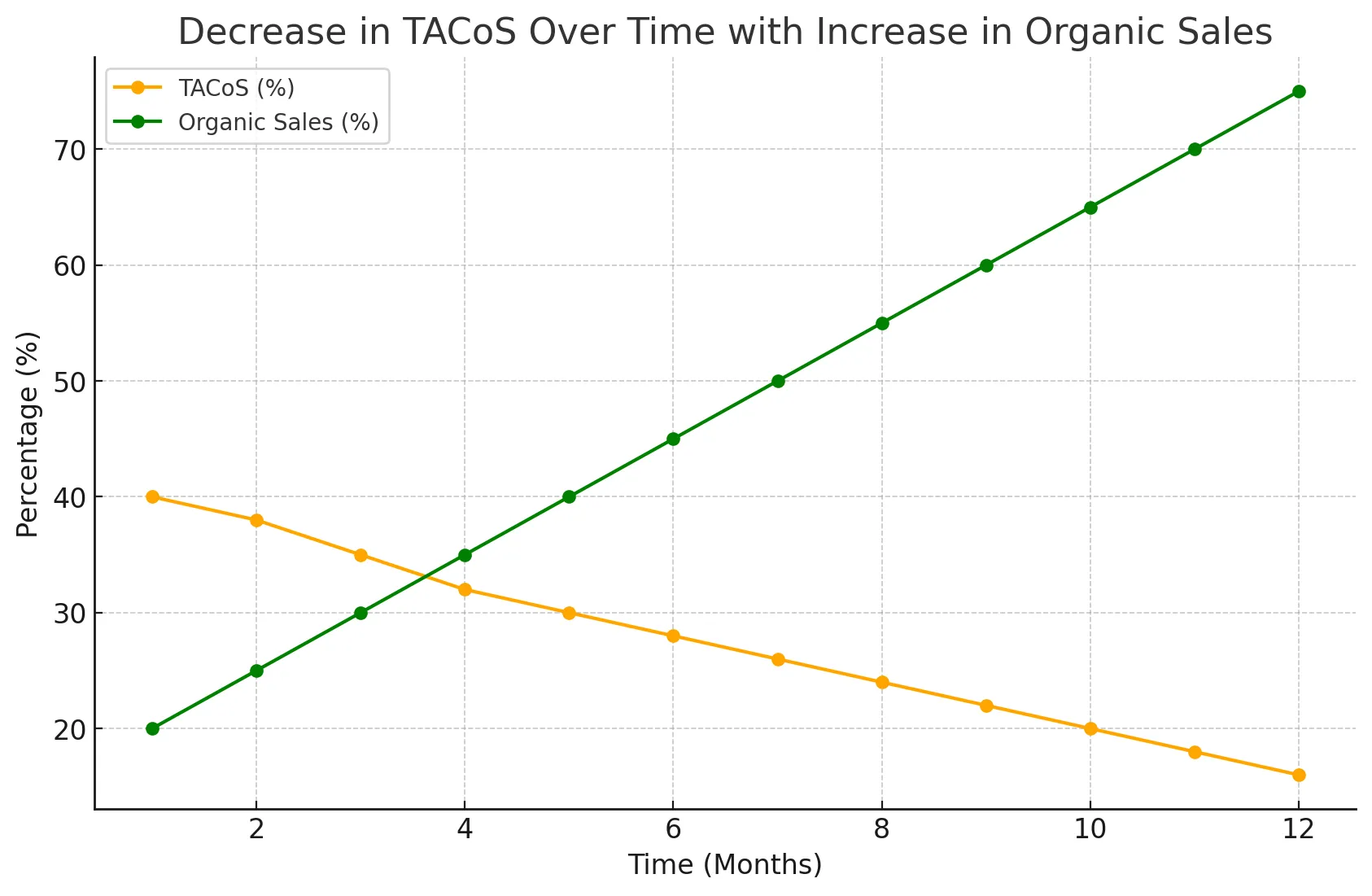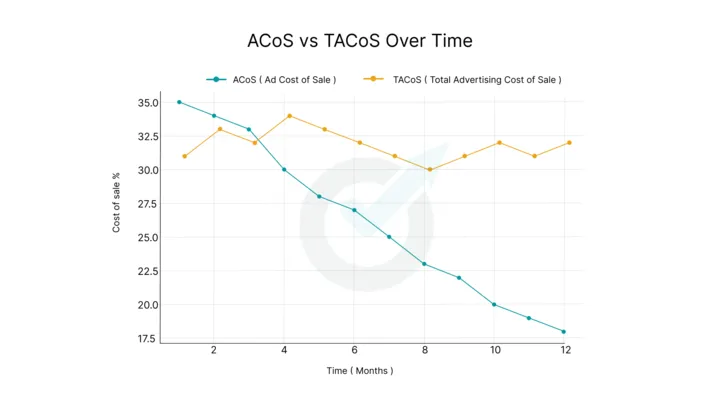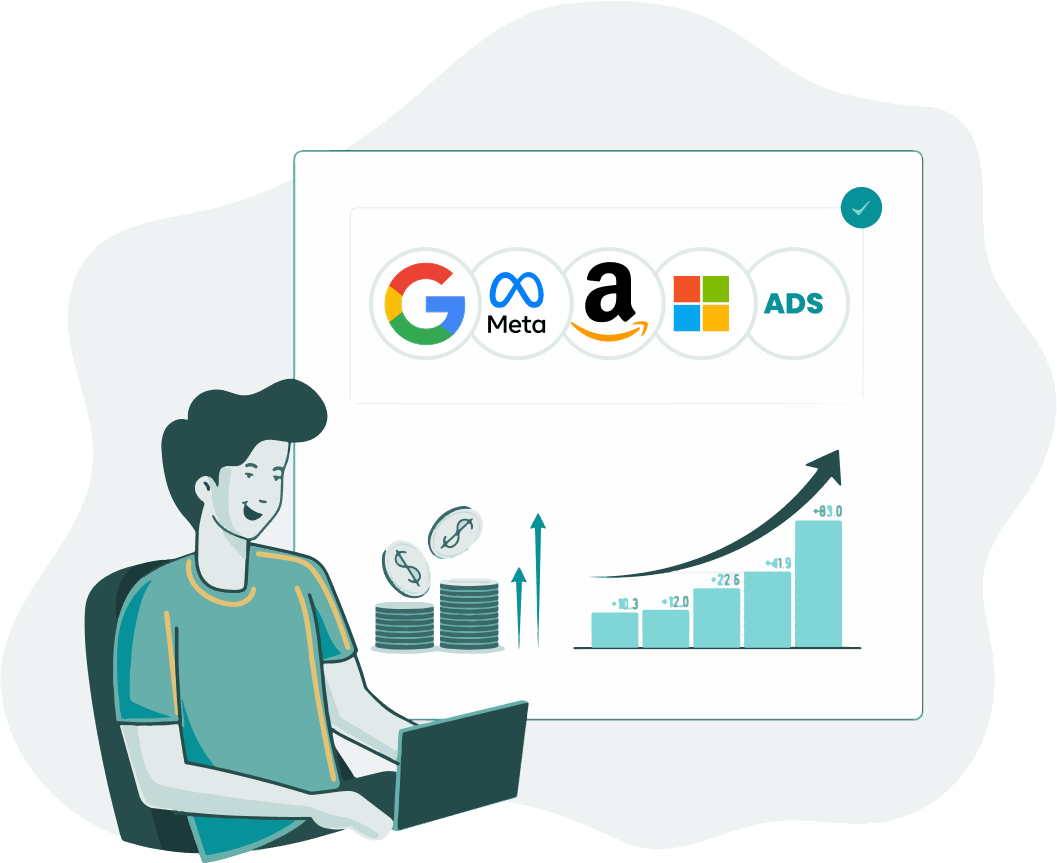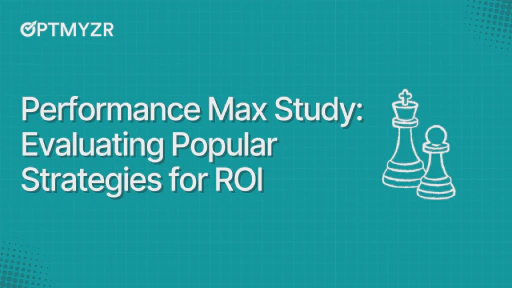Success in advertising isn’t just about driving immediate sales; it’s about building long-term growth and sustainability. While most advertisers rely on metrics like ROAS and ACoS to measure campaign performance on Amazon, these metrics don’t speak to how your overall sales have grown due to your advertising activities.
You need to look beyond short-term wins and focus on strategies that improve your overall paid and organic business growth.
For Amazon advertisers, TACoS is a more robust metric that can provide you with a more complete picture of your campaign’s performance.
In this article, I’ll walk you through everything you need to know to get started with TACoS and how to manage it for greater product visibility and less reliance on ads.
What is Amazon TACoS?
Amazon TACoS, or Total Advertising Cost of Sale, is a metric that measures ad spend against total sales (both ad-driven and organic). Monitoring TACoS enables you to gauge the efficiency and impact of your Amazon ads on a more macro level, as I’ll discuss in the following sections.

Unlike ACoS (Amazon Advertising Cost of Sales; which only accounts for revenue generated through ad-driven sales), TACoS helps you see how your ad efforts contribute to your total sales growth, including organic sales (which might be influenced by advertising).
Why you should consider organic sales when evaluating ad performance
Organic sales (i.e., sales generated through non-paid sources) increase with greater brand awareness or organic rankings, both of which your ads might influence (either directly or indirectly). When you evaluate ad performance with only ACoS, you overlook the long-term impact ads can have on organic sales—whereas TACoS captures the full picture.

Declining TACoS over time shows that your business is becoming less reliant on ads to drive revenue and more on organic growth.
The difference between TACoS, ACoS, and ROAS
Every metric offers a different perspective on advertising efficiency, and understanding each of their distinct roles and the specific insights they provide helps you know which metric(s) to track.
Here’s a quick overview of the metrics:
METRIC | FOCUS | FORMULA | IDEAL USE CASE |
ROAS | Revenue return on ad spend | Ad revenue / Ad Spend | Measuring profitability of ad campaigns |
ACoS | Efficiency of ad-driven sales | (Ad spend / Ad revenue) * 100 | Tracking short-term campaigns focused on direct sales |
TACoS | Impact of ads on total revenue | (Ad spend / Total sales) * 100 | Tracking long-term strategy for balancing ad-driven and organic growth |
Return on Ad Spend (ROAS)
ROAS, or Return on Ad Spend, measures ad efficiency in terms of revenue generated relative to ad spend.

When to track ROAS: Use ROAS to measure campaign-level profitability, especially in paid search and display advertising. Since ROAS only accounts for ad spend and revenue, it omits the impact on organic sales and thus doesn’t provide a complete picture of how your ads affect total sales.
Advertising Cost of Sale (ACoS)
ACoS, or Advertising Cost of Sale, measures the cost of advertising relative to the revenue generated solely from ad-driven sales. You can use it to assess the immediate efficiency of your ad spend (a lower ACoS is more efficient).

When to track ACoS: Use ACoS to answer the question, “How much did I spend to make this sale through ads?” You can also use it to measure campaign performance over the short term (i.e., when the goal is direct sales through ads).
Total Advertising Cost of Sale (TACoS)
TACoS, or Total Advertising Cost of Sale, includes both ad-driven and organic sales to give a fuller picture of the impact of ads on total revenue. It can indicate how your ads contribute to both immediate sales and brand growth over the long run.

When to track TACoS: TACoS is invaluable for guiding long-term strategy. It helps you track organic growth alongside ad spend, making it a key metric for brand-building campaigns where you want to see a reduction in TACoS over time (as organic sales increase). TACoS that declines over time suggests a healthy balance between ad-driven and organic sales, and signals reduced dependency on paid ads.
Why TACoS is north star metric for Amazon advertisers
While ACoS has been the traditional metric Amazon advertisers use to measure ad spend efficiency, we’ve seen (in the previous sections) that it has a very narrow focus.
You need to track TACoS for a more comprehensive picture of your company’s performance. It is important to note again that the goal of investing in advertising is not just to get more ad-driven sales, but also to build awareness, improve rankings, and ultimately lower your reliance on paid ads—all of which you can track by monitoring TACoS.
While ACoS may remain stable or even increase during certain periods, if your TACoS goes down, it’s a sign that your ads are working as planned, creating more organic interest and sales.
So, a lower TACoS means you’re getting more value out of your ad bucks and becoming less dependent on ads to keep sales steady.
In a way, TACoS is like a long-term health check for your ad strategy. If your TACoS is dropping, it’s telling you that your brand is gaining strength organically, which is what every business wants.
Manage TACoS in Amazon Ads: Best practices
Now that you know when to track TACoS, follow the best practices below to ensure that you’re getting actionable insights from this data:
- Include all product variations to avoid skewed data
- Balance between product and brand campaigns
- Track TACoS by product or product group
- Set different KPIs for TACoS at various stages of the product’s lifecycle
1. Include all product variations to avoid skewed data.
Make sure you include all variations of your products (i.e., different sizes, colors, flavors, etc.) when tracking TACoS. This helps you get an accurate view of how your whole product line is performing. With all variations included, you can easily spot which products are naturally gaining organic traction and which ones might still need a little extra ad support.
This will prevent you from overspending on ads for products that are doing well on their own, and enable you to allocate budget where it will make a bigger difference.
2. Balance between product and brand campaigns.
Amazon offers different types of ads to help you reach your goals: Sponsored Brand Ads to build brand awareness and Sponsored Product Ads to drive sales of specific products. Knowing when to use each type can make a big difference in managing your TACoS.
Brand campaigns can have a powerful, long-term impact on TACoS. They work by boosting brand awareness, which translates into more organic sales over time, gradually lowering your TACoS. On the other hand, product-specific campaigns tend to generate quicker sales but often rely more on ad spend, which can keep TACoS higher initially.
A smart approach is to balance your ad spend between these objectives:
- Use brand campaigns for steady, long-term TACoS improvement
- Use product campaigns to drive immediate sales when needed
This way, you’re setting yourself up for both immediate results and lasting growth.
3. Track TACoS by product or product group.
While tracking ACoS at the campaign level can give you some insight into ad performance, it doesn’t tell the whole story—especially since each product behaves differently depending on where it is in its lifecycle.
When you track TACoS at the product level, you get a clearer view of which items are thriving from your ad spend in terms of both paid and organic growth. Products that perform well typically have a lower TACoS because they’re gaining strong organic sales, while newer products may have a higher TACoS as they rely more heavily on ads to get noticed.
If you’re only looking at ACoS, high numbers might seem concerning. But TACoS paints a fuller picture by factoring in organic sales generated by your advertising. In the early stages, you might see a higher TACoS, but as the product gains traction and starts pulling in organic sales, TACoS should naturally decrease.
Tracking TACoS at the product level helps you stay focused on both short-term and long-term goals. It allows you to see where ad spend is working to boost organic growth, so you’re not just chasing immediate results but building a more sustainable business.

ACoS may remain stable or increase, but if a product performs well, tracking TACoS will reveal a decline over time as organic sales grow and reliance on ad spend decreases.
4. Set different KPIs for TACoS at various stages of the product’s lifecycle.
Now that you know that TACoS can vary across product groups and lifecycle stages, it’s good practice to also set different expectations for each group or stage:
PRODUCT SCENARIO | WHAT TO EXPECT | THE GOAL |
Product launches (High TACoS) | Expect a higher TACoS for new launches because they need greater ad investment to drive initial awareness. | At this stage, the goal is to establish product visibility and boost organic ranking over time. |
Established products (Moderate TACoS) | For products that have been around a while or recently went out of stock, TACoS may temporarily increase as ads help re-establish their organic rankings. | Here, the goal is to recover organic traction rather than immediate profitability. |
High-converting products (Low TACoS) | For established products, TACoS should reflect a lower dependency on ads and hold higher organic strength. | The KPI here is a lower TACoS, indicating that the product now sustains on organic sales with minimal ad support. |
How to improve TACoS and overall ad strategy
The bottom line is that lower TACoS means less reliance on ad spend to drive product sales. Follow these tactics to position your product listings for organic growth so that you can divert ad budget to where it’ll make the greatest impact:
- Optimize product listings for organic visibility
- Focus on long-tail keywords in ads
- Leverage seasonal and promotional campaigns
- Use bid adjustments to optimize spend
- Analyze and pause non-performing ads
1. Optimize product listings for organic visibility.
If a product’s TACoS remains high despite consistent ad spend, the listing may need better content. Improve your product titles and descriptions with relevant, high-traffic keywords to increase organic searchability.
High-quality visuals and Enhanced Brand Content (EBC or A+ content) help improve conversion rates, which can drive organic ranking. When your listings are optimized and appealing, you’ll rely less on ads to maintain visibility, which helps bring down TACoS.
2. Focus on long-tail keywords in ads.
Long-tail keywords are usually less competitive and can yield higher conversion rates than more generic head terms. These keywords help drive initial sales without significant ad spend, increasing organic ranking over time and reducing TACoS.
Keep an eye on which keywords perform well and refine your targeting to make sure your product appears in the right searches. Also, be aware that optimizing product listings for long-tail keywords likely means fewer impressions relative to head terms (but, again, these terms should convert more frequently as well).
3. Leverage seasonal and promotional campaigns
Increase ad spend during high-demand seasons like holidays and festivals to maximize sales and organic ranking. Even if TACoS goes up a bit during these periods, the boost to organic sales afterward can be well worth it.
If you run a promotion, monitor TACoS afterward to see if those extra organic sales persist. If so, your strategy has likely helped build a stronger organic presence.
4. Use bid adjustments to optimize spend
Regularly review and pause or lower bids on keywords that don’t convert as well. Direct more budget to high-conversion keywords that support both ad-driven and organic sales to improve TACoS.
Adjust and increase your bids during high-demand times, like holiday seasons, to capture more conversions when shoppers are most active. This can increase ad-driven conversions and reduce the need for ad visibility throughout the year, helping you improve your TACoS over time.
Products with lower TACoS benefit from high organic sales, so you can gradually reduce ad spend and adjust your bids to focus on cost-effective keywords. This frees up budget to support newer or underperforming products. Allocate more budget here and increase your bids to improve visibility and drive early growth.
5. Analyze and pause non-performing ads
Make it a habit to review your ads at regular intervals, pausing any that aren’t bringing in conversions or have a high ACoS. By reallocating budget to ads that consistently perform well, you not only improve immediate results but also increase the chance of these ads positively impacting organic rankings.
Build a sustainable growth strategy with TACoS
Using TACoS effectively means thinking beyond the immediate results of your ads and recognizing the broader role they play in building sustainable, organic growth. By tracking TACoS, you’re able to see not only how your ads perform but also how they help your products gain traction over time.
If you have your TACoS data, Optmyzr can make all actionable steps, like bid adjustments and keyword optimizations, simpler by enabling bulk changes. You can use the Rule Engine to integrate TACoS data directly into your ad strategy and automate your ad spend optimization based on that data.
When tracked efficiently, TACoS can reveal your business’s growing independence from ad spend. It can be your strategic tool for building a stronger, more self-sustaining brand on Amazon.









